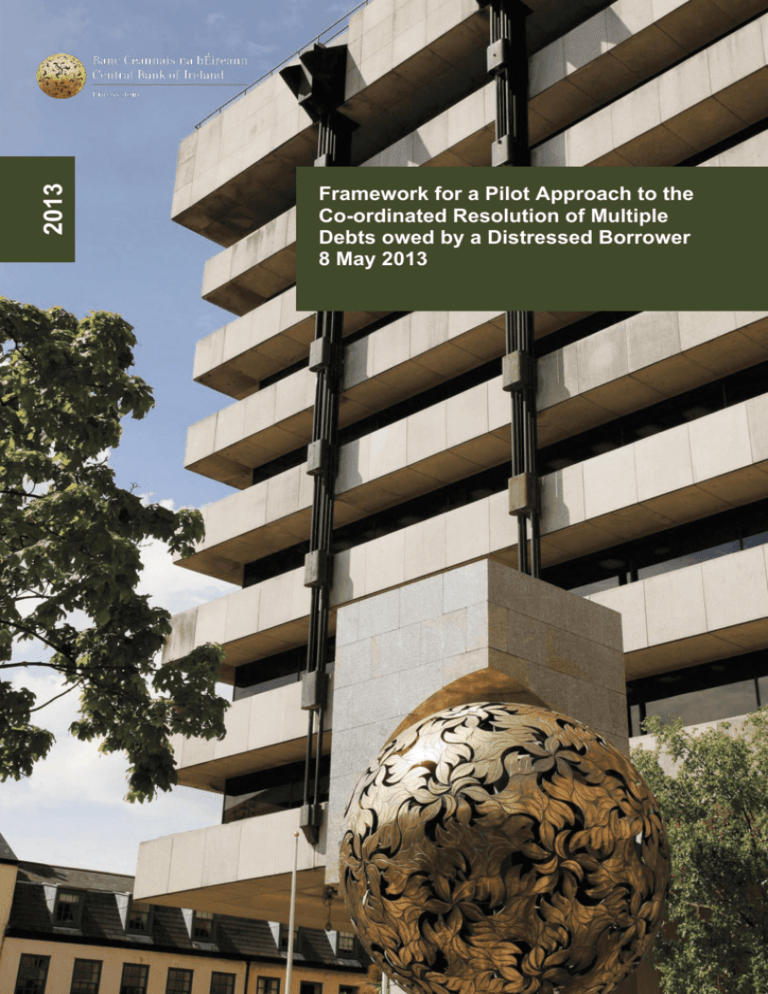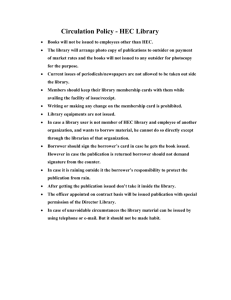Framework for a Pilot Approach to the Co
advertisement

2013 Framework for a Pilot Approach to the Co-ordinated Resolution of Multiple Debts owed by a Distressed Borrower 8 May 2013 2 Contents Introduction ................................................................................................... 3 Scope ............................................................................................................. 4 Principles ....................................................................................................... 5 Restructuring Waterfall ................................................................................. 6 Operation of Waterfall .................................................................................. 8 Significant Mortgage Restructure (Modification H) and Unsecured Debt .... 8 Operation of Framework ............................................................................... 9 Borrowers Obligations and Eligibility .......................................................... 10 Appendix 1 - Lenders Participating in this Framework ............................... 11 2 Introduction 1. This Framework describes a pilot approach by which borrowers with multiple distressed debts can reach fair and equitable solutions with multiple lenders. The aim of the pilot is to enhance co-operation between lenders of secured and unsecured debt in order to fairly resolve distressed debt for the borrower. To facilitate this process for the borrower a third party Service Provider (SP) will operate the pilot. 2. This Framework will be operated on a pilot basis only by participating lenders with a representative sample of borrowers. The pilot scheme will run for three months from commencement and will conclude with a thorough review of the results in order to evaluate the effectiveness of the framework. 3. The participating lenders in this framework will be appended to its final form. 4. Restructuring by lenders will be necessary to deal with many different indebtedness scenarios. In particular, many borrowers experience financial difficulties but are not insolvent. These borrowers will not be eligible to avail of the new insolvency regime and it will be necessary for lenders to co-operate to provide appropriate solutions for such cases. In addition, it is likely that many other cases can be resolved by mutual effort among lenders and the borrower before the difficult insolvency stage is reached. An agreed framework is expected to reduce costs and time for the lenders to reach agreement with borrowers and will facilitate burden sharing arrangements that work sensibly for both secured and unsecured lenders as well as for the individual borrower without the need to proceed to a full debt settlement arrangement, personal insolvency arrangement or bankruptcy. 5. In order that the Framework can be applied, a borrower must be co-operating (as defined in the Code of Conduct on Mortgage Arrears (“CCMA”)) with his/her mortgage lender, must have taken steps to adjust his/her expenditure to established norms and must give consent to a third party independent SP to liaise with all other lenders. 3 6. The Framework will be implemented by all participating lenders and will apply to a borrower who is experiencing significant financial difficulty with regard to the repayment of the mortgage on his/her principal private residence and other debt. 7. The Framework establishes over-arching Principles to be applied in establishing restructuring treatments for borrowers. These Principles apply to the operation of the Framework and to the establishment of debt restructuring solutions. 8. In order that the Principles are applied in a consistent manner, the Framework establishes a Restructuring Waterfall. This sets out the sequence and type of modifications to be applied to distressed debt in order to establish affordable repayment arrangements for the borrower. 9. The Framework may not provide solutions for all borrowers due to the extent of indebtedness relative to available income. For borrowers whose loans are not restructured under this Framework, they may wish to examine other options with their lenders or seek independent advice to understand the options available to them. 10. The Framework is voluntary and it should be noted that all participating borrowers will continue to be covered by the protections of both the CCMA for mortgage debt and the CPC for unsecured debt. Scope 11. This Framework is established for dealing with both secured and unsecured debt, where these debts are across multiple financial institutions or lenders. 12. The lenders participating in this Framework will be set-out in Appendix 1. 13. Debt situations involving Buy to Let Properties (‘BTL’) are not within the scope of this Framework. 14. Debt situations involving business related debts are not within the scope of this Framework. 15. Debt situations where the borrower is deemed to be ‘non-cooperating’, as defined in the CCMA, are not within the scope of this Framework. 4 Principles 16. The Framework will apply to borrowers who have a mix of secured and unsecured debt with multiple lenders and are experiencing significant financial difficulty after taking reasonable steps to maximise income and curtail expenditure. 17. There are two sets of principles, Operating Principles and Debt Resolution Principles. Operating Principles OP 1 OP 2 OP 3 OP 4 OP 5 A third party independent SP will facilitate the implementation of the resolution waterfall by dealing with the borrower on behalf of the participating lenders. The assessment of the borrower’s repayment capability will be based on a Standard Financial Statement The SP will obtain borrower confirmation that there has been a full and transparent disclosure of the borrower’s financial affairs and documentary evidence may be sought by the lender to support this. Any participating lender with material information that suggests the SFS is not accurate will revert to the SP The SP will utilise agreed living expenditure guidelines established by the participating lenders. The SP will propose a restructuring arrangement based upon a resolution waterfall. Debt Resolution Principles DRP1 Application of a standard Framework is designed to produce fair, reasonable and consistent outcomes for dealing with both secured and unsecured debt where there are multiple loans or debts across multiple institutions DRP2 Lenders should endeavour to form arrangements which allow borrowers to remain in their homes where appropriate to their means and needs DRP3 Participating lenders will extend the terms of the loans through term extension and interest rate reduction DRP4 The agreement should reflect the individual circumstances of each borrower and must be based on affordability and must be sustainable for the borrower DRP5 All credit institutions involved must consent to the agreement and must act in good faith DRP6 There should be disclosure to the borrower of any consequences of an agreement such as a longer term for repayment or non-agreement such as putting the home at risk DRP7 All unsecured debt is treated equally 5 Restructuring Waterfall The Framework waterfall provides all lenders and the borrower with a consistent understanding of the type of restructuring that will be required, based on easily understood principles. Multiple Debts Resolution Waterfall Borrower Situation Borrowers debt affordable using standard expenditure levels? No Yes Is affordability shortfall expected to be short-term? No Treatment Yes Affordable if demand credit restructured? No Yes Affordable if unsecured debt duration extended? No Yes Affordable if mortgage duration extended? Yes NoAffordable if interest rate on unsecured debt lowered to 4.5%? No Yes Affordable if mortgage interest rate reduced to 4.5%? Yes No Affordable with Significant Mortgage Restructure? No Yes Full payment of mortgage and other debts A Apply agreed reduced payment to mortgage for duration B Demand credit repayments to be based on a 5 year term and an interest rate of 9%. C Extend term on unsecured debts to maximum allowable D Extend term on both mortgage and unsecured debts to maximum E Extend terms and reduce rate on unsecured debts F Extend terms and reduce rates on all debts G Significant Mortgage Restructure H PIA / Bankruptcy PIA / Bankruptcy 6 I Legend - Explanation of Treatments: A Following assessment of the borrower’s situation against standard affordability and expenditure benchmarks, (through analysis of a completed SFS) the borrowers debts are assessed as affordable. B Expected duration of affordability shortfall is 6 months or less. Full repayment of all debt expected. C Demand credit (overdrafts and credit cards) repayments to be based on a 5 year term and an interest rate of 9%. D Unsecured debt term is extended by 5 years AND demand credit (overdrafts and credit cards) repayments to be based on a 5 year term and an interest rate of 9%. Full repayment of all debt expected. E Unsecured debt term is extended by 5 years AND demand credit (overdrafts and credit cards) repayments to be based on a 5 year term and an interest rate of 9% AND mortgage debt term is extended as required up to a maximum of 65 years of age at maturity. Full principal repayment of all debt expected. F Unsecured debt term is extended by 5 years AND demand credit (overdrafts and credit cards) repayments to be based on a 5 year term and an interest rate of 4.5% AND mortgage debt term is extended as required up to a maximum of age 65 years of age at maturity AND unsecured debt interest rate reduced to 4.5%. Full repayment of principal expected. G Unsecured debt term is extended by 5 years AND demand credit (overdrafts and credit cards) repayments to be based on a 5 year term and an interest rate of 4.5% AND mortgage debt term is extended as required up to a maximum of age 65 years of age at maturity AND Unsecured debt interest rate reduced to 4.5% AND mortgage debt interest rate reduced to a maximum rate of 4.5% (or tracker rate if applicable) for a period of 5 years. Full repayment of all principal expected. H Significant Mortgage Restructure options including split mortgage, negative equity trade down and other solutions I PIA, Bankruptcy or Repossession 7 Operation of Waterfall 18. Modifications to loans will be tested for affordability in the waterfall sequence. The borrower will be offered the first modification which satisfies (tests positive) his or her affordability level. 19. Modification A is a standalone modification. 20. Modifications B to G are cumulative, e.g. modifications B, C, D, E and F are included in modification G. 21. Modification H (significant mortgage restructure) is stand alone after modifications A to G have been exhausted. Significant Mortgage Restructure (Modification H) and Unsecured Debt 22. On a case by case basis and in the context of affordability and the reasonable living arrangements of the borrower, the secured lender will consider a range of significant mortgage restructure options. These arrangements are for the most challenging cases and the reduced payments provided are intended for the benefit of the distressed customer and not for the benefit of any other lender. However on a case by case basis, the secured lender, for a period of two years, may accommodate the servicing of other loans alongside the mortgage on a proportional basis to the remaining sums outstanding. After the two year period, the available cashflow will be used to service the repayments on an appropriate family home. All unsecured debt will be eligible for such treatment with the exception of the two circumstances below: a. An unsecured loan granted in the knowledge that the borrower was in arrears or granted without attempting to establish normal borrower repayment capacity or credit history (e.g. existing arrears). b. An unsecured loan with less than 12 months payments remaining to completion will not be eligible, as the principal on the loan has effectively been repaid with payments already made to date. 8 Operation of Framework 23. A third party independent SP will facilitate the implementation of the resolution waterfall by dealing with the borrower on behalf of the participating lenders. 24. The SP will be responsible for assessing the borrower’s overall financial position and forming a proposal using the Framework waterfall. 25. A participating lender will obtain the consent of the borrower to engage and share information with the SP and other participating lenders. 26. The financial position of the borrower will be compiled using a Standard Financial Statement (SFS). The SP will undertake validation checks of the SFS data and subject to satisfaction that the information supplied is materially complete, will determine income available to meet debt repayments. 27. The income available to meet debt repayment will be based on the SFS information and affordability guidelines that reflect the individual circumstances of each borrower and will result in payments that are sustainable for the borrower. 28. Based on an assessment of the borrower’s repayment capability, the SP will determine a treatment option using the logic outlined in the “Restructuring Waterfall”. The assessment should take into account all current and in some cases future income sources. Where the selection of a treatment option is dependent on an assumed increase in future income there must be a tangible and prudent basis for the inclusion of such an assumption. 29. The SP will inform all participating lenders of the proposed treatment. 30. All participating lenders must review the proposed treatment and inform the SP within 48 hours if they have any additional information which would require the proposal to be re-assessed, or if they object to the proposal. All lenders agree not to unduly oppose a reasonable restructure reflective of the underlying circumstances of a borrower; and must act in good faith at all stages of the process. 31. There must be disclosure to the borrower of any consequences of an agreement (e.g. such as a longer term for repayment or an increase in the cost of credit). 32. The SP must ensure a review of the borrower’s circumstances is undertaken in the event of a borrower request for a change in payment plan and in any event at least every 3 years. 9 Borrowers Obligations and Eligibility 33. Borrowers must agree not to access further credit for the first three years of the treatment. Where borrower circumstances require emergency access to credit the SP may assent to a short duration payment break or in exceptional circumstances will consider additional credit. This will require advance agreement of all lenders. 34. Borrowers must provide a full and transparent disclosure of their financial affairs as part of the debt restructuring process. 35. Borrowers must consent to their SP engaging and sharing information as required in assessing their financial position and forming a proposed treatment. 36. There is a responsibility on borrowers to review and, where necessary, reduce their monthly discretionary spending in line with guidelines determined by the SP to optimise their repayment capability for both secured and unsecured debt. 37. Borrowers must notify their lenders immediately should there be a material change in their financial circumstances so that those changed circumstances may be reassessed. 38. Failure to notify may result in any solution granted within the auspices of this Framework being withdrawn. 39. Where a restructuring has taken place based on false or incomplete information provided by the borrower, the solution granted may be withdrawn. 40. The borrower must consent to the agreement and must have acted in good faith at all stages of the process. 10 Appendix 1 - Lenders Participating in this Framework [to be appended following individual entity notification of participation to CBI] 11 Bosca PO 559, Sráid an Dáma, Baile Átha Cliath 2, Éire PO. Box No 559, Dame Street Dublin 2, Ireland 12







